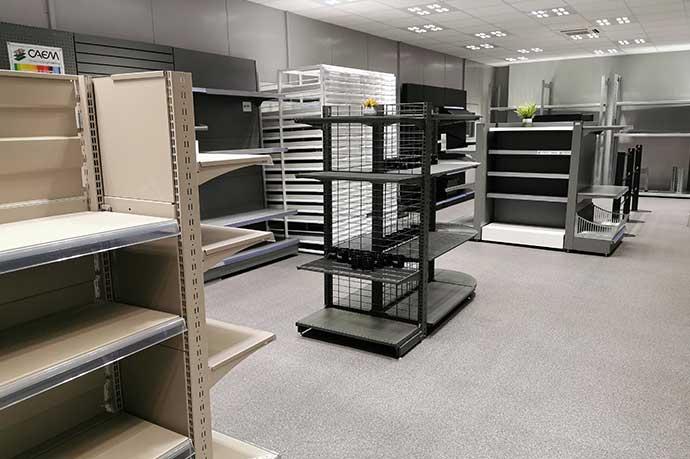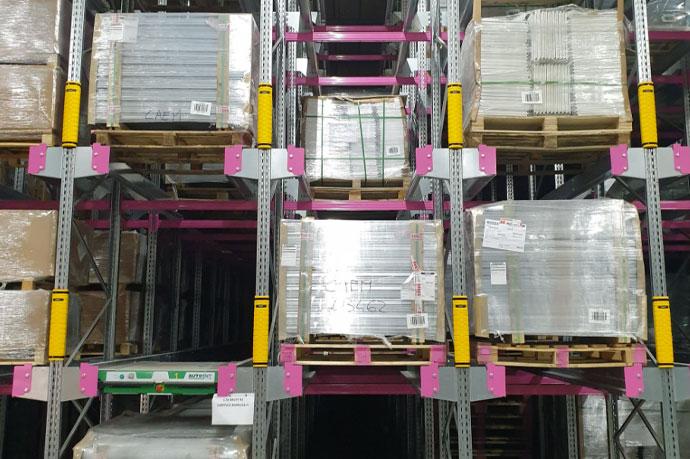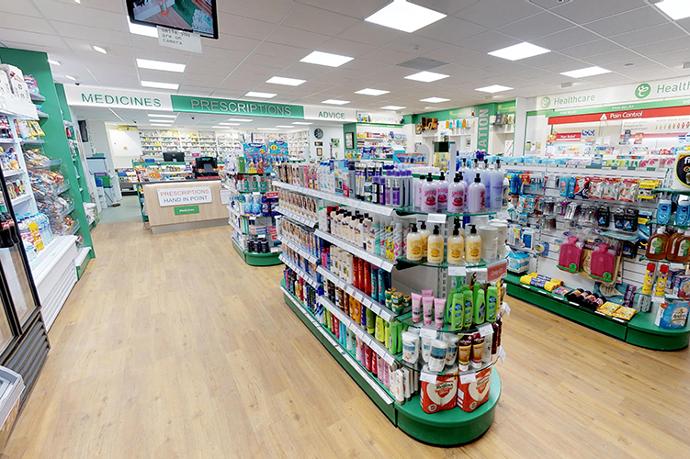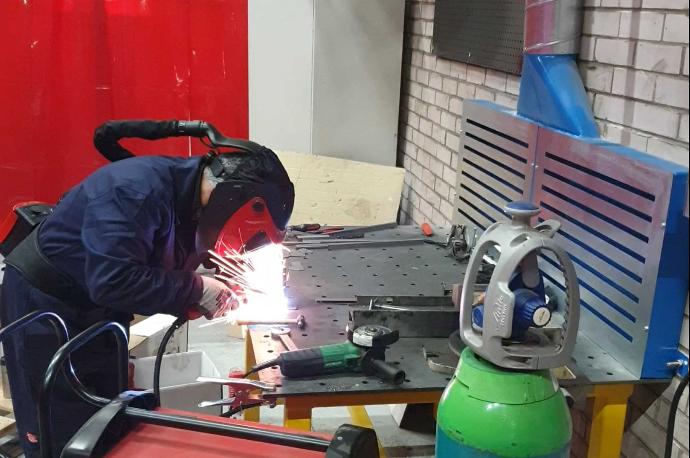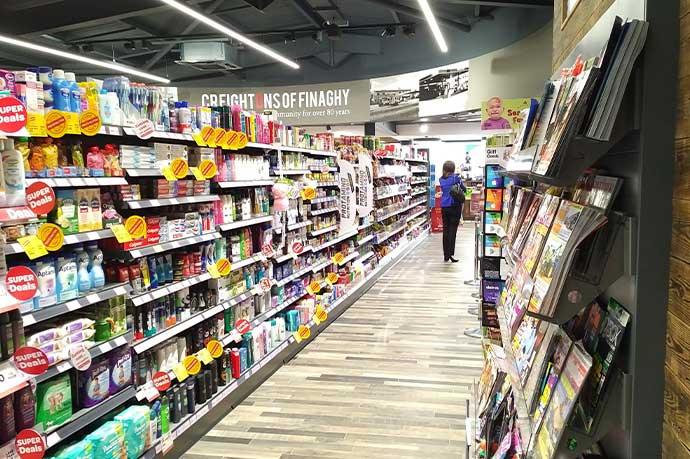The way retailers design their store environments has never mattered more. With the global retail fixtures market valued at USD 2,281.37 million in 2023 and projected to reach USD 3,467.04 million by 2032 with a compound annual growth rate of 4.76%, modular store fixtures represent far more than a passing trend. They've become essential infrastructure for competitive, future-ready retail. CAEM, with over 60 years of shopfitting expertise and a reputation for technical innovation, continues to set the benchmark in modular store fixtures.
This sustained market growth reflects a fundamental shift in how retailers approach space optimization. With nearly 80% of consumers preferring in-store purchases and 72% of sales still occurring in physical stores, investing in adaptable retail infrastructure has become crucial for maintaining competitive advantage.
Understanding Modular Store Fixtures
Definition and Purpose
Modular store fixtures are engineered systems made up of interchangeable components—think shelving, gondolas, wall units, and display tables—that can be configured and reconfigured to suit evolving merchandising needs. Their core purpose extends beyond simple product display to maximize retail space efficiency while maintaining an appealing, organized environment that responds to changing consumer behaviors.
Store design consultant Maria Garcia explains that modular retail fixtures offer flexibility to reconfigure your store layout for seasonal changes or promotions. This adaptability enables quick transformation without costly renovations or bespoke construction, allowing retailers to respond swiftly to market demands and inventory changes.
Key Benefits for Retailers
The advantages of modular systems have been proven across diverse retail environments. Adaptability leads the benefits, with displays updating rapidly to match fresh inventory or campaigns. These systems deliver space-saving solutions, higher SKU density, and streamlined maintenance protocols. CAEM's own modular shelving delivers increased product visibility and merchandising capacity, supporting expanded product ranges without visual clutter.
Beyond immediate operational benefits, the flexibility to expand or reconfigure layouts as business needs evolve translates into substantial long-term savings. Industry experts emphasize that investing in modular retail fixtures provides long-term value through adaptability to changing retail trends. For staff, intuitive assembly and reconfiguration empower teams to manage floor changes without outside labor, while extensive customization options reinforce brand identity and create distinctive shopping environments.
Types of Modular Store Fixtures
Gondolas and Shelving Units
Gondola shelving remains a cornerstone of retail store displays, particularly in grocery and general merchandise environments. These freestanding units, such as CAEM's TN9 and S50 systems, are engineered for central aisles or perimeter walls and can be tailored to accommodate everything from high-density grocery displays to boutique product arrangements. Adjustable shelf heights and diverse finish options support a wide range of merchandise categories and retail concepts, from warehouse-style bulk displays to premium product presentations.
Slatwall and Pegboard Systems
Slatwall and pegboard systems provide vertical merchandising flexibility, accepting numerous hooks, baskets, and shelving accessories. Their modular nature supports frequent merchandising updates, making them particularly valuable for fast-moving retail environments or specialty categories like apparel, electronics, and seasonal merchandise where product mix changes regularly.
Grid Panels and Accessories
Grid panel systems function as customizable frameworks for hanging products, baskets, or promotional signage. Available as wall-mounted or freestanding configurations, they allow for easy addition or removal of accessories based on seasonal needs or promotional requirements. Their adaptability makes them particularly effective for stores that rotate inventory frequently or require versatile product presentations across multiple categories.
Countertops and Display Tables
Countertops and modular display tables serve as focal points for featured products, impulse purchases, or checkout areas. Advanced options like nesting tables or tiered display systems enhance visual merchandising impact while maximizing limited floor space. Mobile tables equipped with casters support dynamic seasonal displays or temporary promotional events, allowing retailers to transform spaces quickly for specific campaigns.
Floor and Wall Displays
Floor displays encompass towers, racks, and showcases designed to maximize product visibility while remaining easily repositioned to highlight new arrivals or promotional items. Wall-mounted modular units make strategic use of vertical space, contributing to organized and efficient layouts while supporting creative merchandising solutions that draw customer attention upward and throughout the store environment.
Customization Options for Fixtures
Interchangeable Components
Interchangeability forms the foundation of effective modular display systems. Retailers can swap shelves, hooks, signage holders, and specialized accessories to refresh displays or accommodate new product categories without replacing entire fixture systems. CAEM's TN9 and M25 systems exemplify this approach, allowing for precise shelf placement and effortless reconfiguration as merchandising needs evolve.
The modular construction approach enables retailers to mix and match elements for different product types, adjust heights and dimensions as needed, and facilitate easy assembly and disassembly for quick layout changes. This flexibility proves particularly valuable during seasonal transitions or when introducing new product lines.
Finish and Material Choices
Contemporary modular fixtures offer extensive finish and material options, from powder-coated steel and zinc-coated frames to premium wood, glass, and laminate surfaces. CAEM provides custom color matching and specialized surface textures to help retailers create distinctive atmospheres and maintain brand consistency across multiple locations.
Branding and Signage Integration
Modern retail store fixtures are engineered with comprehensive branding integration in mind. Custom graphics, logos, and directional signage can be incorporated directly into fixture units, ensuring cohesive messaging throughout the store environment. The modular design philosophy means these branding elements can be updated, repositioned, or replaced as marketing strategies evolve without requiring complete fixture replacement.
Lighting and Electrical Features
Lighting integration plays a critical role in product visibility and overall store atmosphere. Many contemporary modular systems include built-in LED shelf lighting, digital display capabilities, or customer convenience features like charging stations. CAEM's Ardente LED shelf lighting system not only highlights high-value merchandise but also creates more engaging shopping experiences that encourage extended browsing and increased purchase consideration.
Selecting the Right Fixtures for Your Store
Assessing Your Store Layout
Begin with comprehensive floor plan analysis, documenting ceiling heights, natural traffic patterns, and key architectural features. Modular fixtures can be customized to fit unique spaces or challenging architectural elements, ensuring optimal utilization of every available square meter while maintaining intuitive customer flow.
Understanding Customer Flow and Behavior
Observing actual shopper movement patterns provides crucial insights for fixture placement decisions. Well-designed modular retail displays support intuitive navigation, strategically spotlight bestselling products, and encourage exploration of secondary merchandise categories. This principle applies whether you're operating a compact boutique or managing a sprawling supermarket environment.
Aligning Fixtures with Product Types
Different product categories demand specific display solutions for optimal presentation. Apparel requires hanging systems and adjustable configurations; grocery items benefit from variable shelving heights and easy restocking access; electronics call for secure, highly visible display cases. CAEM's comprehensive range spans from the high-capacity LS9 system for warehouse-style environments to specialized modular drawer systems for pharmacy and health product applications.
ROI and Cost-Benefit Analysis
Understanding Investment Returns
The robust market growth trajectory, with the retail fixtures sector expanding at 4.76% CAGR through 2032, reflects the tangible returns retailers experience from modular fixture investments. This sustained growth indicates that businesses consistently find positive value in upgrading their fixture systems.
Key ROI factors include reduced labor costs for layout changes, extended fixture lifecycles through component replacement rather than full system replacement, and improved space utilization that increases revenue per square foot. The adaptability of modular systems means retailers avoid costly renovations when introducing new product lines or responding to seasonal demands.
Payback Period Considerations
While specific payback periods vary by retailer size and implementation scope, the market's continued expansion suggests that modular fixtures typically deliver value within reasonable timeframes. The ability to reconfigure existing components for new applications extends the effective lifespan of initial investments while reducing ongoing capital expenditure requirements.
Operational efficiency gains from streamlined maintenance, reduced installation time, and simplified staff training contribute to shorter payback periods. These factors become particularly significant for multi-location retailers where standardized systems create economies of scale across their entire network.
DIY Assembly and Installation Tips
Tools and Equipment Needed
Most modular fixtures are engineered for straightforward assembly using standard tools commonly available in retail environments. CAEM provides comprehensive installation guides and instructional videos for each system, making professional-quality setup accessible for store teams without requiring specialized labor or extensive technical training.
Step-by-Step Assembly Guide
Assembly typically follows logical sequences: establish level base components, attach vertical uprights securely, position shelving elements at desired heights, and add specialized accessories or branding elements. Modular components are designed to fit together reliably using clearly marked connection points, while detailed manufacturer instructions ensure safe, stable installation that meets commercial retail standards.
Time Estimates and Troubleshooting
Basic gondola systems can typically be assembled by two-person teams within 30-45 minutes per unit, while more complex configurations with integrated lighting or specialized accessories may require 60-90 minutes. Common troubleshooting involves ensuring level foundations, verifying component compatibility, and confirming proper torque specifications for connection hardware.
Maintenance and Care
Routine maintenance involves regular cleaning with appropriate commercial cleaners and periodic inspection of connection points and moving parts. The modular design advantage becomes evident during maintenance, as individual components can be replaced quickly without affecting entire fixture systems. This approach preserves investment value while minimizing operational disruption during busy retail periods.
Innovative Trends in Modular Store Fixtures
Sustainability and Eco-Friendly Materials
Sustainability has become standard practice rather than optional consideration. Retailers are prioritizing fixtures made from recycled or renewable materials, with energy-efficient lighting and recyclable components becoming baseline expectations rather than premium features. These choices reduce environmental impact while appealing to increasingly eco-conscious consumers who factor sustainability into their shopping decisions.
The shift toward sustainable materials includes recycled metals, FSC-certified woods, and low-impact laminates that maintain durability while supporting environmental responsibility goals. This trend reflects broader consumer expectations and regulatory pressures that make sustainability a business necessity rather than marketing option.
Tech Integration and Smart Fixtures
Smart fixture integration has evolved beyond simple additions to become integral components of modern retail operations. RFID-enabled shelves provide real-time inventory management, interactive digital signage enhances customer engagement, and integrated charging stations improve convenience for mobile-dependent shoppers.
These technological enhancements support omnichannel retailing by connecting physical displays with digital inventory systems, customer mobile applications, and e-commerce platforms. The result is seamless customer experiences that bridge online and offline shopping behaviors.
Adjustable and Mobile Fixtures
Flexible and modular fixture designs enable retailers to reconfigure store layouts without costly renovations, supporting cost-efficiency while reducing material waste from frequent fixture replacements. Mobile fixtures on casters allow for rapid seasonal transitions, promotional setups, or experiential retail activations that create buzz and drive traffic.
This flexibility proves particularly valuable for retailers managing seasonal inventory, promotional campaigns, or pop-up retail concepts where layout requirements change frequently.
Experience-Enhancing and AR Integration
To differentiate physical retail experiences, stores are implementing fixtures that create immersive and shareable experiences, including AR mirrors for virtual try-ons and Instagram-worthy display setups. These installations attract foot traffic and encourage brand loyalty by making in-store shopping more interactive and memorable.
Omnichannel Integration
Fixtures now support omnichannel strategies by integrating technology that connects physical shopping with online personalization and inventory visibility. This includes devices that communicate with mobile apps and e-commerce platforms, facilitating seamless customer journeys across channels while supporting unified retail experiences.
Case Studies: Successful Implementations
Small Boutique Store Examples
Boutiques thrive on differentiation and efficient space utilization. CAEM's modular store fixtures have helped independent retailers and franchises maximize limited space while supporting rapid layout changes that reinforce unique brand identities. The Yorkshire Convenience Store Franchise exemplifies this approach, leveraging modular shelving to create efficient, visually appealing displays within compact environments while maintaining operational flexibility for seasonal merchandise changes.
The modular approach allows boutique retailers to experiment with different layouts, test customer response to various configurations, and adapt quickly to new product introductions without major capital investment in fixed fixtures.
Large Retail Chain Examples
For major retail chains, scalability and consistency are fundamental requirements. Major brands including Boots, Tesco, and Sainsbury's have implemented CAEM's systems for nationwide rollouts, benefiting from standardized fixtures that can be tailored for local market needs while maintaining brand consistency.
The Body Project Australia case study demonstrates comprehensive modular implementation using M25 shelving systems with custom color coordination and integrated LED lighting. This installation created distinctive product zones while maintaining cohesive store aesthetics that reinforce brand positioning in the competitive sports nutrition market.
Large-scale implementations benefit from standardized training programs, simplified maintenance protocols, and bulk purchasing advantages that improve overall project economics while ensuring consistent customer experiences across multiple locations.
Managing Cost and Budget
Finding Affordable Solutions
Modular fixtures accommodate diverse budget requirements through scalable system designs and standardized component approaches. CAEM's S50 system exemplifies budget-conscious solutions designed for retail environments requiring cost-effective refurbishment without compromising functionality or visual appeal. The ability to retrofit new components onto existing fixtures further reduces upfront investment requirements.
Evaluating Long-Term Investment Value
Quality modular store fixtures deliver strong ROI through enhanced durability, operational adaptability, and simplified maintenance requirements. Investment in expandable systems like CAEM's TN9 or M25 means fewer complete replacements and ongoing operational savings through extended component lifecycles and reduced labor requirements for layout modifications.
The long-term value proposition becomes evident through adaptability to changing retail trends, reduced renovation costs, and improved operational efficiency that supports business growth without proportional increases in infrastructure investment.
Leasing vs. Purchasing Fixtures
Financing decisions depend on business strategy, cash flow considerations, and expansion plans. Modular designs support both leasing arrangements that provide flexibility and purchasing strategies focused on long-term asset ownership. The durability and adaptability of quality modular systems make them suitable for both approaches while maintaining value throughout their operational lifecycle.
Addressing Common Challenges
Maximizing Space in Small Stores
Space optimization becomes critical for urban retailers and boutique environments where every square meter directly impacts revenue potential. CAEM's M25 system addresses these challenges by optimizing floor area through intelligent design that provides expanded display capacity within compact footprints. Modular solutions also enable creative vertical space utilization and efficient corner configurations that would be impossible with fixed fixtures.
Maintaining Aesthetic Consistency
Brand consistency across multiple locations requires coordinated fixture systems with standardized finishes, accessories, and signage integration capabilities. Modular systems excel in this application because they ensure cohesive visual presentation while allowing for component updates that keep stores aligned with evolving brand standards without complete fixture replacement.
The Future of Modular Store Fixtures
Evolving Consumer Expectations
Contemporary shoppers expect engaging, flexible, and immersive retail environments that respond to their preferences and provide memorable experiences. Modular fixtures empower retailers to adapt quickly to changing consumer tastes, new product launches, and experiential retail trends without major disruption or investment in completely new infrastructure.
The rise of pop-up stores and small-format retail creates new opportunities for adaptable fixtures that can be easily configured, transported, and reconfigured for different applications and locations.
Anticipated Innovations and Developments
Future developments in modular store fixtures will emphasize deeper technology integration, enhanced sustainability features, and even more sophisticated analytics capabilities. Expected innovations include improved IoT connectivity, advanced materials with enhanced durability and environmental benefits, and AI-powered optimization systems that recommend optimal configurations based on sales data and customer behavior patterns.
The continued expansion of modular construction approaches, projected to grow by USD 7.37 billion from 2024-2028, suggests broader adoption of modular principles across retail and commercial construction sectors.
Conclusion: Elevating Retail Experiences with Modular Fixtures
Recap of Benefits and Potential
Modular store fixtures have transformed from innovative solutions to essential retail infrastructure. Their adaptability, cost-effectiveness, and operational simplicity make them indispensable for contemporary retail environments, supporting everything from boutique installations to large-scale corporate rollouts. Quality modular systems position retailers for immediate merchandising improvements while providing the flexibility needed for long-term growth and market adaptation.
Taking the Next Steps Towards Upgrading
Retailers ready to enhance their environments should begin with comprehensive needs assessment, explore available customization options, and consult with experienced professionals who understand both technical requirements and business objectives. With CAEM's comprehensive consultation and design services, every project benefits from decades of industry expertise, collaborative design processes, and customized modular solutions that transform retail concepts into successful operational realities.
Additional Resources
Further Reading and Professional Guides
Explore CAEM's comprehensive shelving and racking guide for detailed information on modular retail display solutions, innovative store concepts, and case studies demonstrating quantifiable results across diverse retail environments. These resources provide valuable insights into system selection, implementation strategies, and optimization techniques that maximize return on fixture investments.
Consultation and Design Services
CAEM offers complete project support from initial consultation through custom design, prototyping, and professional installation services. This ensures each fixture system is precisely matched to operational requirements and brand objectives. Whether planning boutique renovations or coordinating nationwide rollouts, CAEM's expert team provides the technical knowledge and project management expertise needed to create efficient, future-ready retail environments that drive business success.
For more information or to discuss your next project, visit CAEM's official website and discover how modular store fixtures can transform your retail space.
